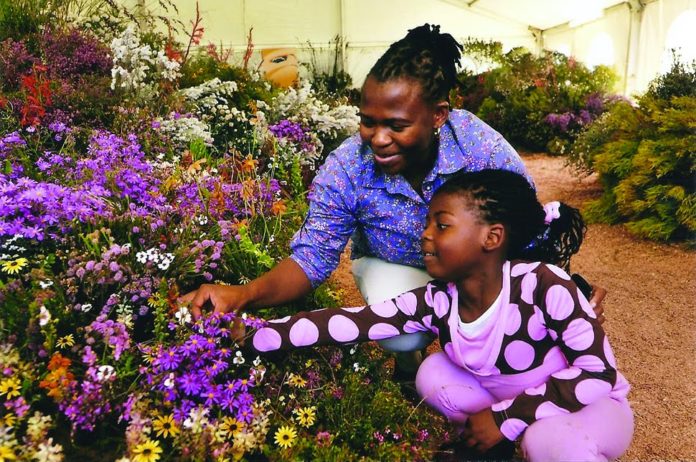 |
It takes one small step to make a difference, and when Bea Heymann visited the West Coast community of Mamre, she began a journey of upliftment and activism that has had a powerful impact on the place and its people.
“When I first went to Mamre, I realised that the little town incorporated nearly everything that I was interested in and passionate about, from its Cape Dutch vernacular architecture to its fascinating history, as well as the stunning West Coast spring flowers, the unusual West Coast traditional foods, and the culture and lifestyle of this rural Moravian Mission community,” says Bea. “It may be close to Cape Town, but it was so very different in every way from my own background, history and culture.” “At that time Mamre was very run down, dilapidated and neglected, and the people were obviously poor, yet the potential for change and revitalisation seemed so clear,” she explains. “I decided to try do whatever I could to help bring prosperity to Mamre, and to help restore the people’s pride in their town, their heritage and their culture. Although it did seem an overwhelmingly large task, I reminded myself of the words of Henry Ford: ‘Whether you believe you can do a thing or not, you are right.’”
From nature gardens to newspapers
The first project Bea embarked on was a Spring Festival with a landscaped flower show, which has grown each year, and this year celebrated its 10th anniversary. Next was the establishment of a community organic vegetable garden, which is now thriving. It supplies the soup kitchen for the needy and the community, and will eventually supply Mamre’s restaurant and farmstall with fresh vegetables. Its location was carefully chosen, and it is positioned where it had been 200 years ago.
Other projects include the collection of oral histories, especially from the oldest people in Mamre; establishing hiking and bicycle routes; creating a recycling depot; clearing alien invasive vegetation; upgrading and managing a Nature Garden; unblocking Mamre’s rivers; training local youth in newspaper production; creating a local newspaper and many more initiatives. Projects are chosen to benefit and uplift the community either directly or through the creation of job opportunities and skills training; and with the aim of attracting visitors to Mamre, as tourism will help the projects to be sustainable.
It soon became clear that a properly-structured organisation was needed to handle all this, so the Mamre Community Development Trust was created, with Bea as CEO. The Trust comprises only three trustees from outside Mamre, with the other five selected from the community. The Trust is a PBO with coveted Section 18A status, enabling donors to deduct any donation from their income tax, which is a good incentive.
All this has been a long road to travel, with many challenges along the way. What has motivated Bea as she carries out this work day by day? “I think the prospect of being instrumental in making a difference to the lives of an entire community is my main motivation,” she says. “Another motivating factor is the restoration and reviving of the historical buildings on the ‘werf’, which if not constantly maintained will disappear and be lost forever, taking with them an important part of South Africa’s history. “The rescue, protection and conservation of the environment are yet another motivation. I think that these issues are too important and exciting to abandon, tempted though I am from time to time when the going gets difficult!”
A new tourism destination
Capetonians love trips up the West Coast, and Bea recommends visiting Mamre on your next break: “Mamre will have all the attributes of a first class tourism destination, and is a designated Provincial Heritage site (formerly called a National Monument). It is very beautiful, with ancient oak trees shading the old Cape Dutch buildings, and has two rivers running through it.
“It is only a 45 minutes drive from Cape Town, so is very conveniently situated for Sunday lunch or weekend visit. There are many other attractions in the area, such as the Fossil Park; !kwattu, — the San cultural centre; an ostrich park; the West Coast National Park and more. At Mamre there is an old water mill (which will be restored to working order) a bakhuisie (where bread will once again be baked in the old-fashioned way), and there will be a first class country style restaurant, a guest house, a small conference centre (in the original old school where the Missionaries taught the Khoi) and there could be a series of shops in the langhuis, (formerly a barracks for D.E.I.C. soldiers) such as a bakery, a book shop, a gift shop, a craft shop, a farmstall and a deli.
Meanwhile, it is easy for you to get involved. “If there are any Cape Jewish Chronicle readers who would like to assist with one of the projects, I would be so glad to hear from them. If there is someone skilled in writing a Business Plan that would be especially welcome. We have already started a ‘Friends of Mamre’ group that readers might also like to join. There is no cost for joining, as this is a support group which will be kept in touch with what is happening at Mamre. Members will also benefit from special offers when the tourism project is up and running.” In conclusion, Bea quotes Robert F. Kennedy, who said, “‘There are those who look at things and ask why… I dream of things that never were, and ask why not?’ Come and help to make the dream a reality at Mamre.”
Contact Bea on beabarry@iafrica.com or 021 433-2221.











